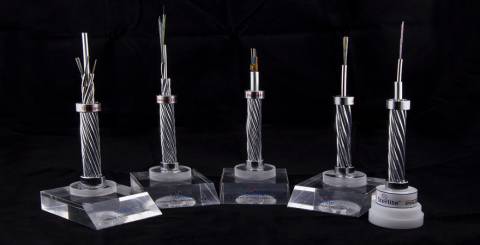The History and Future of OPGW Fiber Optic Cable

The advent of Optical Fiber Grounding Wire or OPGW revolutionized the electrical as well as the telecommunications industry as it opened the doors for greater efficiency and faster communications. The OPGW fiber optic cable started gaining popularity in the 1980s and is still the preferred grounding wire in many places. The start of the new century saw a boom in the use of OPGW cables and Asia emerged as the largest market for these cables. The success of OPGW (Optical Ground wire cables) cables is due to the fact that these cables offer dual functionality. The primary use of OPGW is that of a grounding cable which shields the overhead lines from lightning and the ability to use the same cable for transmitting data over long distances made it an instant hit with the transmission companies as well as telecom companies. The transmission companies can use these cables for their own need of transmitting data through a secure channel amongst its offices at different locations and they could also lease it out or sell it to telecom companies and generate extra revenue.
The only hurdle which comes in way of leasing or selling the fiber optic line to telecom carriers is the right of way. If the RoW was taken for electrical transmission line then the transmission company cannot sell or lease the same line for other services; this can only be made possible if a separate RoW is taken for telecom or data transfer use. The OPGW fiber optic cable finds favor with the transmission companies just because it provides them with an opportunity to earn extra money from the infrastructure they set up for transmission of electricity. Most of the companies which are in the business of transmission line construction use OPGW cables for grounding. Installation of the OPGW cables is costlier and complex than that of the traditional all metal grounding cables thus we find these cables only in new transmission line constructions and not on the old ones.
Let’s take a look at the benefits for a telecom company which decides to use the OPGW cables of a transmission company.
- The telecom company does not have to invest time and money on installation of fiber optic line
- Saves cost of labor and machinery for laying underground cables
- Telecom companies can further their reach to areas which were inaccessible due to lack of infrastructure
- Faster and safer transmission of voice and data
- Easy fault detection on overhead lines as compared to the underground cables
The transmission companies are trying their best to project the OPGW (Optical Ground wire cables) fiber optic cable as the best solution to the needs of telecom companies in terms of a high-speed secure way of transmitting data, video, and voice. The future of OPGW cables is quite bright as the companies would certainly find more uses of these cables in near future and the growth of telecom industry is bound to increase the demand for these cables in future. Advancement in technology means that we can possibly see much-improved versions of these cables in future which could further enhance the services. The manufacturers are also striving hard to come up with a wider range of products to ensure that they can fulfill the needs of all kinds of telecom and electricity distribution companies. It is only through a constant evaluation of the products and the global standards that they can get to know the scope of improvement in each product they offer. The possibilities for the manufacturers and telecom companies are endless if they can tap the true potential of this excellent product.
Similar Articles
Discover how expert book printing solutions transform manuscripts into high-quality printed books. Learn about the process, materials, customization options, eco-friendly practices, and the future of modern book printing.
Architectural 3D rendering price guide covering costs, factors, AI impact, and typical pricing for residential and commercial exterior and interior renders.
Most large organisations already know how hard enterprise application testing can be. You’ve got old and new systems talking to each other, custom code layered on vendor platforms
When it comes to working at heights, safety and efficiency are paramount. Aerial work platforms (AWPs) have revolutionized how professionals approach elevated tasks across countless industries, from construction sites to warehouse operations.
The modern age of customers expect constant availability, no matter what the offer. And for that, the market requires rapid innovation cycles. In such a high stakes environment, technology infrastructure is more than just a cost center.
When evidence seals fail, cases weaken. Explore how compromised chain of custody can derail investigations and jeopardize justice.
Compare hydraulic and traction residential elevators to find the best fit for your home. Learn how each system works, their pros and cons, space needs, energy use, and maintenance requirements.
Extend the lifespan of your commercial marina docks with proactive maintenance. Learn essential inspection routines, material-specific care, and safety tips to protect your investment and ensure long-term dock performance.
Learn the key factors in designing an engineered fall protection system. Discover how hierarchy of controls, task analysis, structural integrity, and fall clearance ensure safety and compliance.









